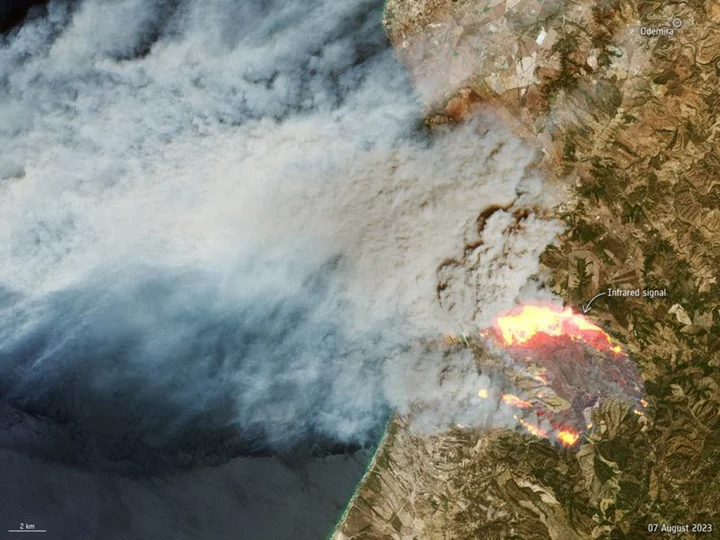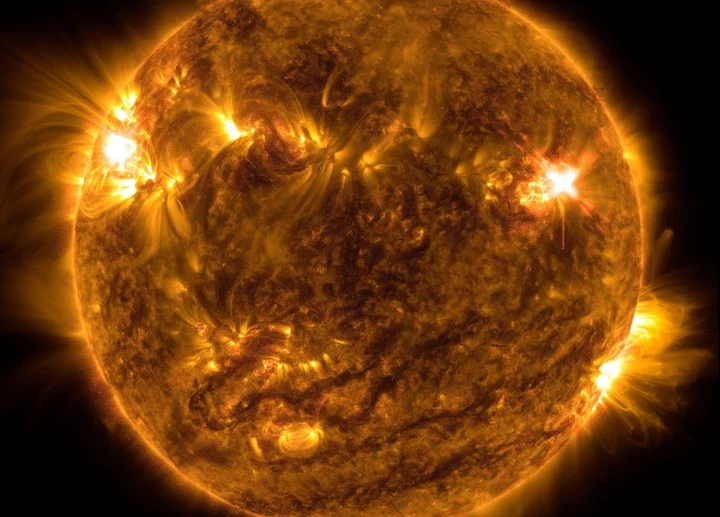
Europe space chief warns over political wavering on climate
By Tim Hepher PARIS Europe's top space official has urged wavering politicians not to abandon European leadership in
1970-01-01 08:00

US space startups' latest struggles marked by layoffs, shake-ups
By Joey Roulette WASHINGTON U.S. space startups have slashed workforces and restructured operations to survive amid an investment
1970-01-01 08:00

Highest-paid NBA player on each team in 2023: Which teams are spending max contracts wisely?
Who is the highest-paid NBA player on each team? Are teams spending their max contracts wisely like the Denver Nuggets with Nikola Jokic and the Los Angeles Lakers with LeBron James?NBA teams have a limited amount of resources to build a championship team. The salary cap, Bird rights, max contra...
1970-01-01 08:00

Russian scientists start processing first data on Luna-25 craft - space agency
MOSCOW (Reuters) -Russian scientists have started processing the first data received on the Luna-25 spacecraft after switching on the scientific
1970-01-01 08:00

3 Vikings who locked up roster spot, 1 on verge of being cut in preseason Week 1
The Minnesota Vikings opened preseason Week 1 with a loss to the Seahawks. But three players earned their roster spots, while one is now a cut candidate.The Minnesota Vikings opened up the preseason on Thursday night, traveling to the Pacific Northwest for a date with Drew Lock -- a lot of Drew ...
1970-01-01 08:00

Russia says it downs Ukrainian drone west of Moscow, two airports reopen
MOSCOW Russian air defences on Friday downed a Ukrainian drone as it flew towards an unspecified target in
1970-01-01 08:00

Russia launches lunar lander in race to find water on moon
By Guy Faulconbridge and Joey Roulette MOSCOW (Reuters) -Russia launched its first moon-landing spacecraft in 47 years on Thursday in
1970-01-01 08:00

Virgin Galactic: First space tourism mission after decades of promises
Keisha Schahaff and UK student Ana Mayers become the first mother-daughter duo to travel to the edge of space.
1970-01-01 08:00

Virgin Galactic: Mum, daughter and Brit, 80, count down to space flight
Virgin Galactic aims to fly an 80-year-old former Olympian, a mother and her daughter into space.
1970-01-01 08:00

Perseids 2023: Meteor beacon offers unique way to observe spectacular shower over UK
A group of amateur radio enthusiasts have set up a beacon in the UK that allows anyone to observe meteors as they burn through the Earth’s atmosphere. The UK Meteor Beacon project uses radio signals to identify meteorites as they pass through a 400 km-wide section of sky over England and Wales. The data is then displayed on a live online feed, with meteors appearing as blue streaks that emit a ping followed by a trailing pitch. The system captures more than 100 meteors every hour, even during times of relatively low activity. For the upcoming Perseid meteor shower, which peaks on 12 August, the frequency could be in the region of thousands per hour as Earth passes through the tail of the Swift-Tuttle comet. Unlike optical astronomy, the use of radio signals mean that meteors can be observed in nearly any weather conditions at all hours of the day and night. It also means that the system can pick up smaller meteors that may not appear as ‘shooting stars’ to the naked eye. This method of observation could potentially lead to the discovery of new meteor showers, which could then be tracked to uncover previously unknown comets. The radio transmitter is based at the Sherwood Observatory near Mansfield in Nottinghamshire, however receivers can be placed anywhere in the country. “The transmitter is illuminating the sky above Mansfield with radio signals that can be reflected by meteors and their trails,” Brian Coleman, who designed the system’s hardware and has a receiver in his back garden, told The Independent. “Even outside the Perseids and other meteor showers we’re seeing them at a rate of two a minute – and we can observe them day and night no matter what the weather. Only thunderstorms and lightning can interfere with it.” It is the first meteor beacon system run by amateur radio and astronomy volunteers in the UK, and has already received funding from the Radio Society of Great Britain and the British Astronomical Association. It has also gained the attention of academic and citizen scientists keen on studying meteors. Setting up the beacon transmitter is only the first part of the project, with the four-person team now planning to design and deploy echo receivers that can be distributed throughout the country at distances of up to 1,200 km from the Sherwood Observatory. The receivers can be built for as little as £10, according to Mr Coleman, using plastic pipes and other materials found in DIY stores. His hope is that the low cost will encourage schools to set up their own receivers to develop STEM-related projects that will encourage students to explore radio engineering and astronomy. Observations of the meteors from different directions can also be used to calculate the location and trajectory of meteors, with the team currently trying to establish whether it is possible to triangulate the meteors by studying the horizontal lines and blue smudges that appear on the waterfall display. Such measurements are currently possible with military-grade pulse radar systems, but it has never been done before on this scale. If it is possible, then knowing the speed and direction of the meteors will allow them to calculate the landing spot of any meteors that make it through the Earth’s ionosphere without burning up completely. These samples can then be studied to offer a better understanding of the universe. “The ultimate ambition is to have a system like Blitzortung, which uses a network of ground-based detectors to track live lightning strikes around the planet,” Mr Coleman said. “If successful, we could observe meteors entering Earth’s atmosphere in real-time throughout the world – but there’s still a lot of work to do before we achieve that.” Read More Amateur astronomers make ‘major breakthrough’ in saving Earth from asteroids ‘It’s becoming like an airport’: How SpaceX normalised rocket launches Perseid meteor shower offers best chance to see a ‘shooting star’ in 2023 Watch live: Russian cosmonauts step out of ISS to perform spacewalk Earth hit by powerful ‘X-1’ solar flare, after fears of ‘cannibal’ blast
1970-01-01 08:00

Earth hit by powerful ‘X-1’ solar flare, after fears of ‘cannibal’ blast
The Earth narrowly avoided being hit by a “cannibal” solar flare – but has been lashed by powerful enough blasts to disrupt communications. In recent days, space weather forecasters had warned that the Earth could be hit by a range of powerful flares that have been ejected from the Sun. Particular warnings focused on the “cannibal” flare, which was forecast to potentially glance Earth. “Cannibal” solar flares are formed when a later blast catches up with one that was ejected earlier, and consumes it. The energy of the two is combined, which can make them far more powerful than flares that are released on their own. The latest cannibal flare appears to have missed Earth, however. Forecasts had suggested that it was only expected to glance the planet, and so a miss was perhaps likely. The Earth was struck by an X-class flare, however. That is the most potent category of solar flares, and can cause considerable disruption on Earth. This time around, space weather experts warned that the blast was enough to disrupt radio and navigation signals in North America. It was measured as an R3 blackout – on a scale that runs from 1 to 5 – which meant that areas in the US and Canada as well as on the Pacific Ocean were at risk of having radio signals and navigation disrupted. The Sun moves through a cycle of activity every 11 years, during which it releases more and less “coronal mass ejections” or CMEs, and it is currently in a particularly busy part of that cycle. Those CMEs can bring energetic flares that hit Earth – and could one day cause considerable problems on the planet, disrupting energy grids and other important infrastructure. The latest flare was measured at X1.5 and is the 20th such X flare to have hit the Earth in its current period. It came out of a particularly active part of the Sun, and followed other, weaker flares, the UK’s Met Office said. Nonetheless, experts said the “minor ongoing solar radiation storm” was “waning” and that it did not expect significant disruption in the coming days. Read More Giant space ‘umbrella’ tethered to asteroid could protect Earth from climate crisis James Webb Space Telescope captures new images of the Ring Nebula Massive solar storm strikes Earth, Moon and Mars together for first time in history
1970-01-01 08:00

NFL Rumors: Steelers standouts, Vikings UDFA shining, Colts screw Saints
NFL Rumors: Colts screw over Saints in Kareem Hunt pursuitAll systems appeared to be a go for the New Orleans Saints to sign Kareem Hunt. In the wake of the three-game suspension for running back Alvin Kamara, the organization brought in one of the best available veteran free agents and ESPN'...
1970-01-01 08:00
